An Academic Essay on Starbucks' Failure in the Australian Market
VerifiedAdded on 2023/01/13
|9
|2478
|2
Essay
AI Summary
This essay critically evaluates the reasons behind Starbucks' failure in the Australian market. It begins with an introduction highlighting the company's initial expansion plans and subsequent losses, including the closure of numerous stores. The main body of the essay provides a detailed analysis of the factors contributing to Starbucks' decline, such as the company's premium pricing strategy, failure to meet consumer expectations, and lack of adaptation to the existing coffee culture. It assesses the impact of the global business environment, including cultural differences, competitor analysis, and customer preferences. The essay examines the role of information asymmetries, time-inconsistent preferences, and the influence of government and regulatory bodies. The essay highlights the importance of understanding local market dynamics, consumer behavior, and competitive landscapes for global business success. The conclusion summarizes the key findings, emphasizing the importance of adapting strategies to local contexts and consumer preferences. The essay uses peer-reviewed journal articles to support its arguments, providing a comprehensive analysis of the Starbucks case in Australia.
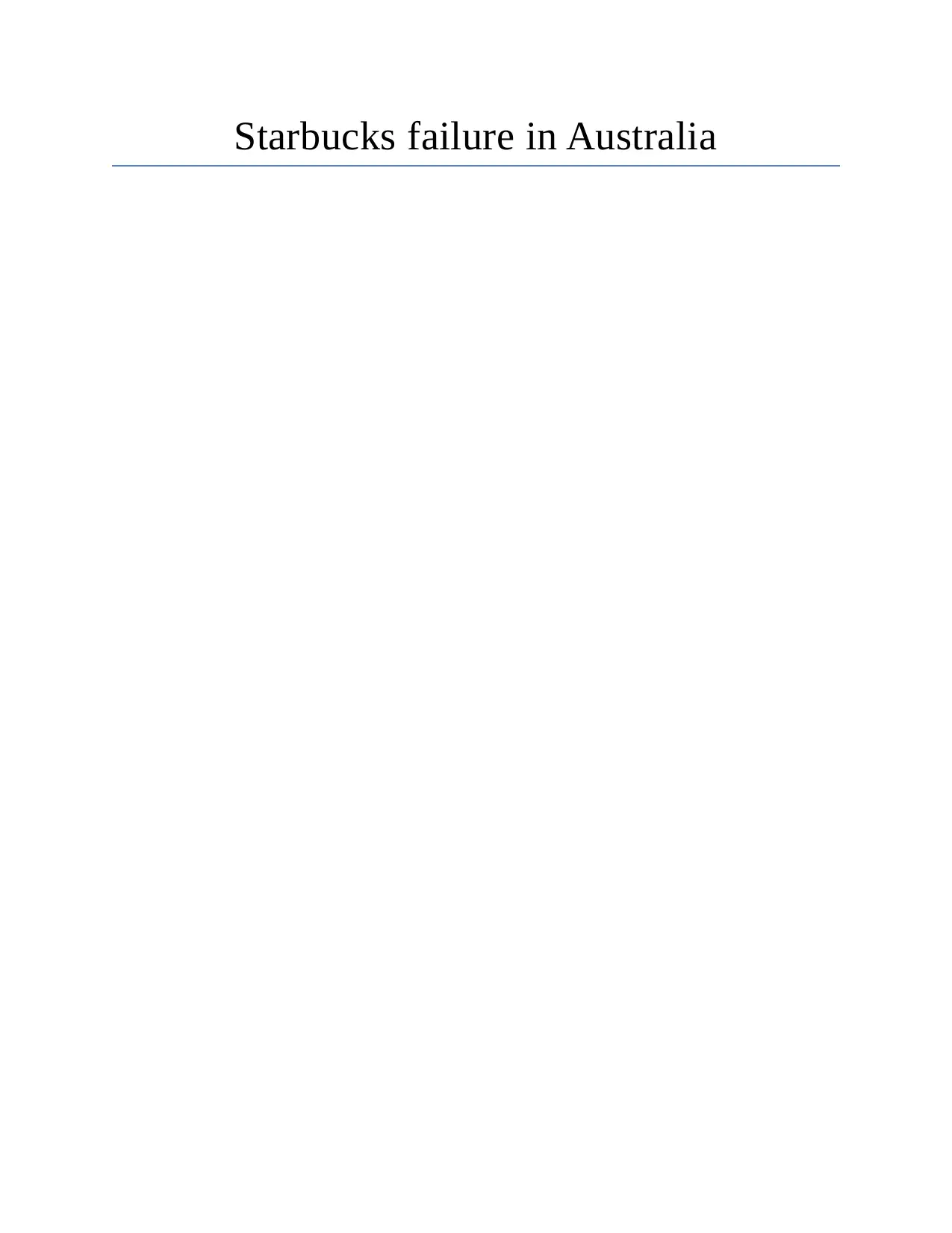
Starbucks failure in Australia
Paraphrase This Document
Need a fresh take? Get an instant paraphrase of this document with our AI Paraphraser
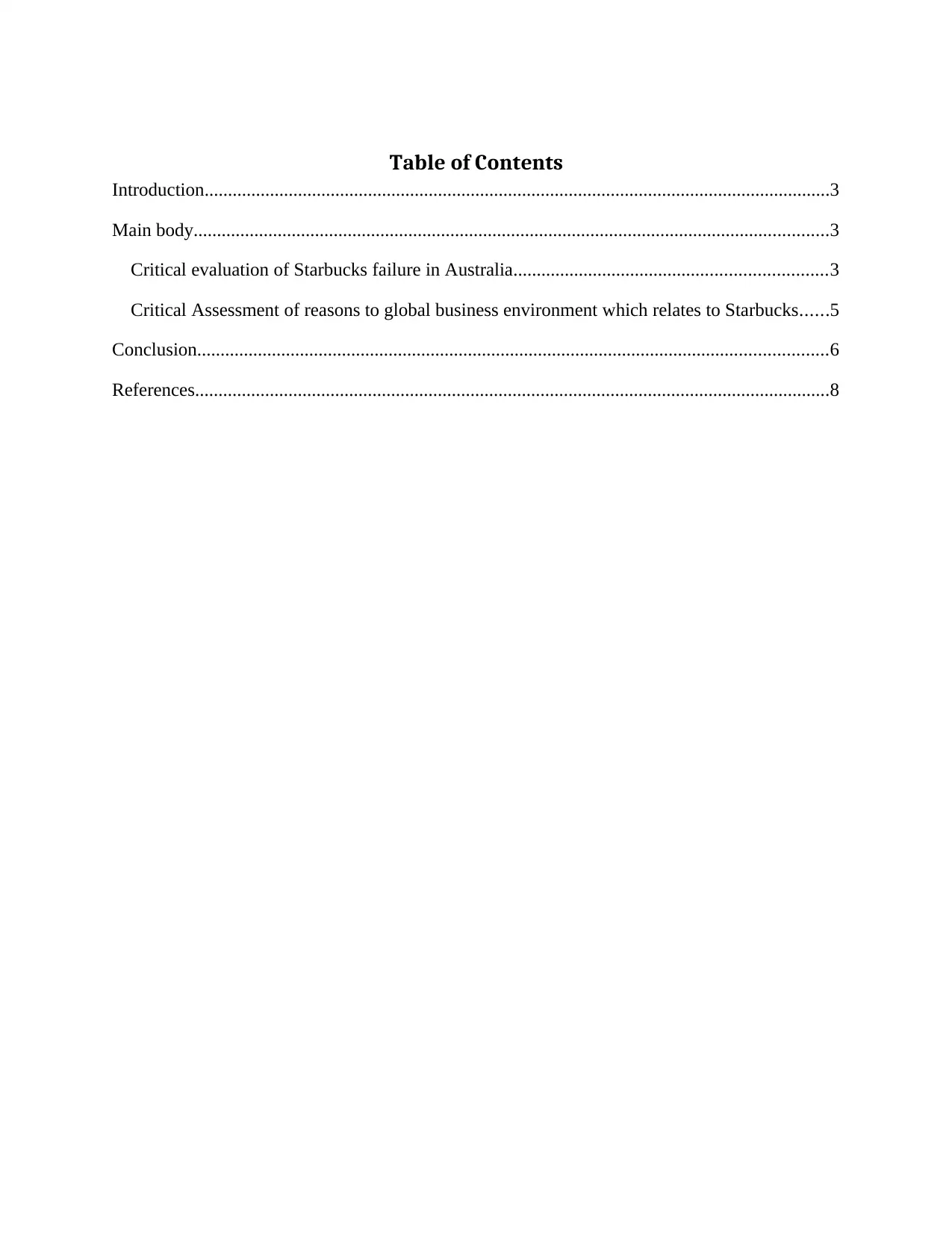
Table of Contents
Introduction......................................................................................................................................3
Main body........................................................................................................................................3
Critical evaluation of Starbucks failure in Australia...................................................................3
Critical Assessment of reasons to global business environment which relates to Starbucks......5
Conclusion.......................................................................................................................................6
References........................................................................................................................................8
Introduction......................................................................................................................................3
Main body........................................................................................................................................3
Critical evaluation of Starbucks failure in Australia...................................................................3
Critical Assessment of reasons to global business environment which relates to Starbucks......5
Conclusion.......................................................................................................................................6
References........................................................................................................................................8
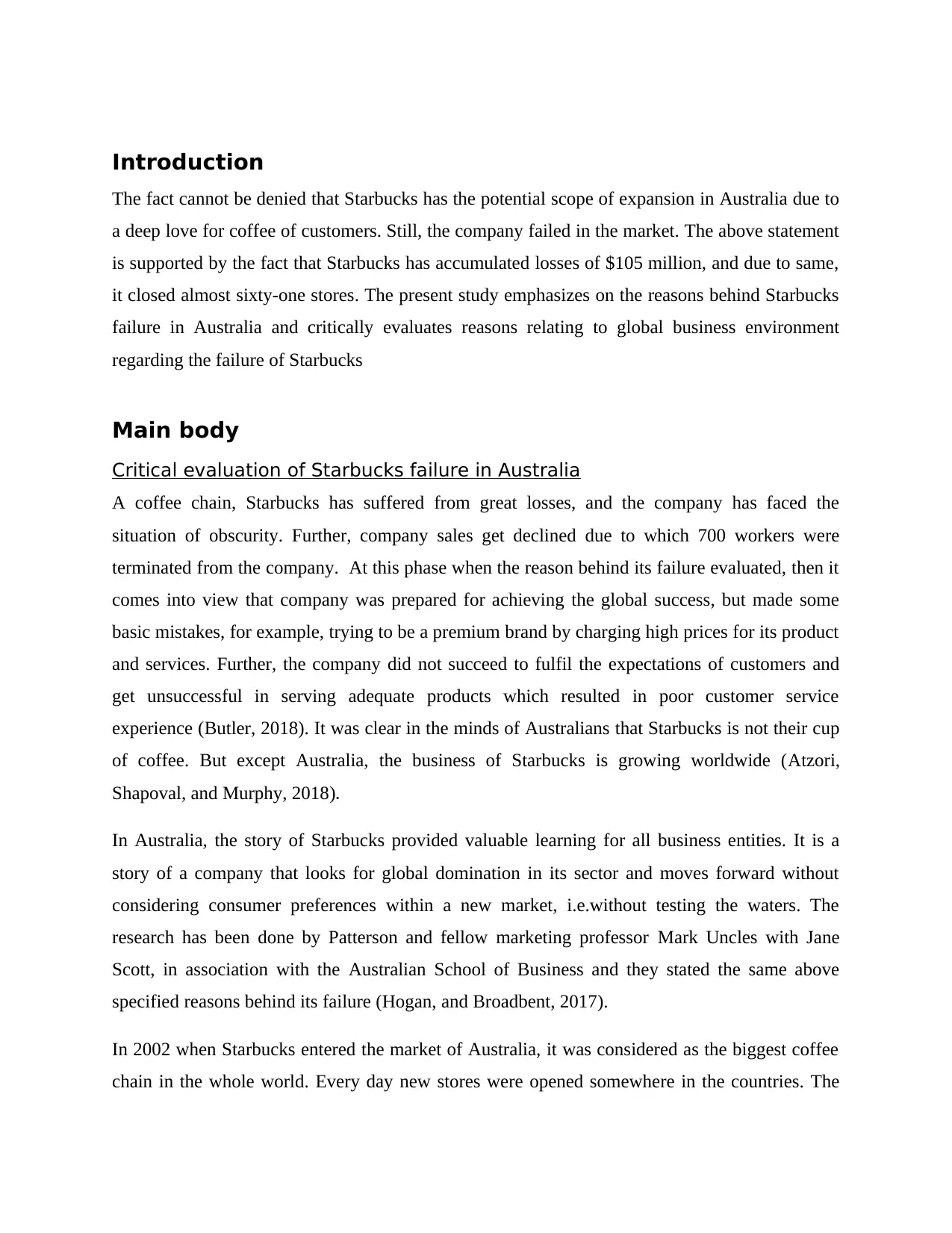
Introduction
The fact cannot be denied that Starbucks has the potential scope of expansion in Australia due to
a deep love for coffee of customers. Still, the company failed in the market. The above statement
is supported by the fact that Starbucks has accumulated losses of $105 million, and due to same,
it closed almost sixty-one stores. The present study emphasizes on the reasons behind Starbucks
failure in Australia and critically evaluates reasons relating to global business environment
regarding the failure of Starbucks
Main body
Critical evaluation of Starbucks failure in Australia
A coffee chain, Starbucks has suffered from great losses, and the company has faced the
situation of obscurity. Further, company sales get declined due to which 700 workers were
terminated from the company. At this phase when the reason behind its failure evaluated, then it
comes into view that company was prepared for achieving the global success, but made some
basic mistakes, for example, trying to be a premium brand by charging high prices for its product
and services. Further, the company did not succeed to fulfil the expectations of customers and
get unsuccessful in serving adequate products which resulted in poor customer service
experience (Butler, 2018). It was clear in the minds of Australians that Starbucks is not their cup
of coffee. But except Australia, the business of Starbucks is growing worldwide (Atzori,
Shapoval, and Murphy, 2018).
In Australia, the story of Starbucks provided valuable learning for all business entities. It is a
story of a company that looks for global domination in its sector and moves forward without
considering consumer preferences within a new market, i.e.without testing the waters. The
research has been done by Patterson and fellow marketing professor Mark Uncles with Jane
Scott, in association with the Australian School of Business and they stated the same above
specified reasons behind its failure (Hogan, and Broadbent, 2017).
In 2002 when Starbucks entered the market of Australia, it was considered as the biggest coffee
chain in the whole world. Every day new stores were opened somewhere in the countries. The
The fact cannot be denied that Starbucks has the potential scope of expansion in Australia due to
a deep love for coffee of customers. Still, the company failed in the market. The above statement
is supported by the fact that Starbucks has accumulated losses of $105 million, and due to same,
it closed almost sixty-one stores. The present study emphasizes on the reasons behind Starbucks
failure in Australia and critically evaluates reasons relating to global business environment
regarding the failure of Starbucks
Main body
Critical evaluation of Starbucks failure in Australia
A coffee chain, Starbucks has suffered from great losses, and the company has faced the
situation of obscurity. Further, company sales get declined due to which 700 workers were
terminated from the company. At this phase when the reason behind its failure evaluated, then it
comes into view that company was prepared for achieving the global success, but made some
basic mistakes, for example, trying to be a premium brand by charging high prices for its product
and services. Further, the company did not succeed to fulfil the expectations of customers and
get unsuccessful in serving adequate products which resulted in poor customer service
experience (Butler, 2018). It was clear in the minds of Australians that Starbucks is not their cup
of coffee. But except Australia, the business of Starbucks is growing worldwide (Atzori,
Shapoval, and Murphy, 2018).
In Australia, the story of Starbucks provided valuable learning for all business entities. It is a
story of a company that looks for global domination in its sector and moves forward without
considering consumer preferences within a new market, i.e.without testing the waters. The
research has been done by Patterson and fellow marketing professor Mark Uncles with Jane
Scott, in association with the Australian School of Business and they stated the same above
specified reasons behind its failure (Hogan, and Broadbent, 2017).
In 2002 when Starbucks entered the market of Australia, it was considered as the biggest coffee
chain in the whole world. Every day new stores were opened somewhere in the countries. The
⊘ This is a preview!⊘
Do you want full access?
Subscribe today to unlock all pages.

Trusted by 1+ million students worldwide
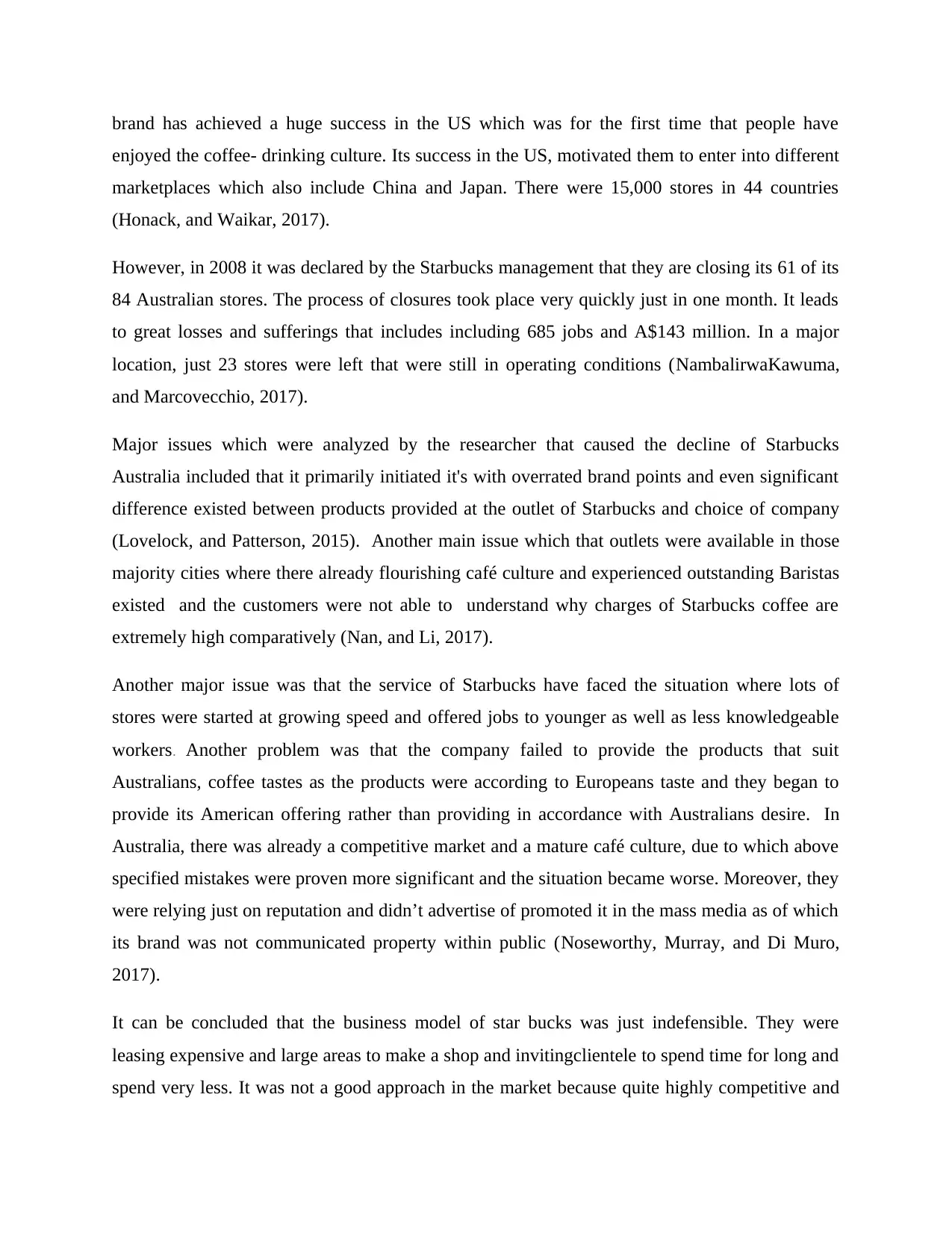
brand has achieved a huge success in the US which was for the first time that people have
enjoyed the coffee- drinking culture. Its success in the US, motivated them to enter into different
marketplaces which also include China and Japan. There were 15,000 stores in 44 countries
(Honack, and Waikar, 2017).
However, in 2008 it was declared by the Starbucks management that they are closing its 61 of its
84 Australian stores. The process of closures took place very quickly just in one month. It leads
to great losses and sufferings that includes including 685 jobs and A$143 million. In a major
location, just 23 stores were left that were still in operating conditions (NambalirwaKawuma,
and Marcovecchio, 2017).
Major issues which were analyzed by the researcher that caused the decline of Starbucks
Australia included that it primarily initiated it's with overrated brand points and even significant
difference existed between products provided at the outlet of Starbucks and choice of company
(Lovelock, and Patterson, 2015). Another main issue which that outlets were available in those
majority cities where there already flourishing café culture and experienced outstanding Baristas
existed and the customers were not able to understand why charges of Starbucks coffee are
extremely high comparatively (Nan, and Li, 2017).
Another major issue was that the service of Starbucks have faced the situation where lots of
stores were started at growing speed and offered jobs to younger as well as less knowledgeable
workers. Another problem was that the company failed to provide the products that suit
Australians, coffee tastes as the products were according to Europeans taste and they began to
provide its American offering rather than providing in accordance with Australians desire. In
Australia, there was already a competitive market and a mature café culture, due to which above
specified mistakes were proven more significant and the situation became worse. Moreover, they
were relying just on reputation and didn’t advertise of promoted it in the mass media as of which
its brand was not communicated property within public (Noseworthy, Murray, and Di Muro,
2017).
It can be concluded that the business model of star bucks was just indefensible. They were
leasing expensive and large areas to make a shop and invitingclientele to spend time for long and
spend very less. It was not a good approach in the market because quite highly competitive and
enjoyed the coffee- drinking culture. Its success in the US, motivated them to enter into different
marketplaces which also include China and Japan. There were 15,000 stores in 44 countries
(Honack, and Waikar, 2017).
However, in 2008 it was declared by the Starbucks management that they are closing its 61 of its
84 Australian stores. The process of closures took place very quickly just in one month. It leads
to great losses and sufferings that includes including 685 jobs and A$143 million. In a major
location, just 23 stores were left that were still in operating conditions (NambalirwaKawuma,
and Marcovecchio, 2017).
Major issues which were analyzed by the researcher that caused the decline of Starbucks
Australia included that it primarily initiated it's with overrated brand points and even significant
difference existed between products provided at the outlet of Starbucks and choice of company
(Lovelock, and Patterson, 2015). Another main issue which that outlets were available in those
majority cities where there already flourishing café culture and experienced outstanding Baristas
existed and the customers were not able to understand why charges of Starbucks coffee are
extremely high comparatively (Nan, and Li, 2017).
Another major issue was that the service of Starbucks have faced the situation where lots of
stores were started at growing speed and offered jobs to younger as well as less knowledgeable
workers. Another problem was that the company failed to provide the products that suit
Australians, coffee tastes as the products were according to Europeans taste and they began to
provide its American offering rather than providing in accordance with Australians desire. In
Australia, there was already a competitive market and a mature café culture, due to which above
specified mistakes were proven more significant and the situation became worse. Moreover, they
were relying just on reputation and didn’t advertise of promoted it in the mass media as of which
its brand was not communicated property within public (Noseworthy, Murray, and Di Muro,
2017).
It can be concluded that the business model of star bucks was just indefensible. They were
leasing expensive and large areas to make a shop and invitingclientele to spend time for long and
spend very less. It was not a good approach in the market because quite highly competitive and
Paraphrase This Document
Need a fresh take? Get an instant paraphrase of this document with our AI Paraphraser
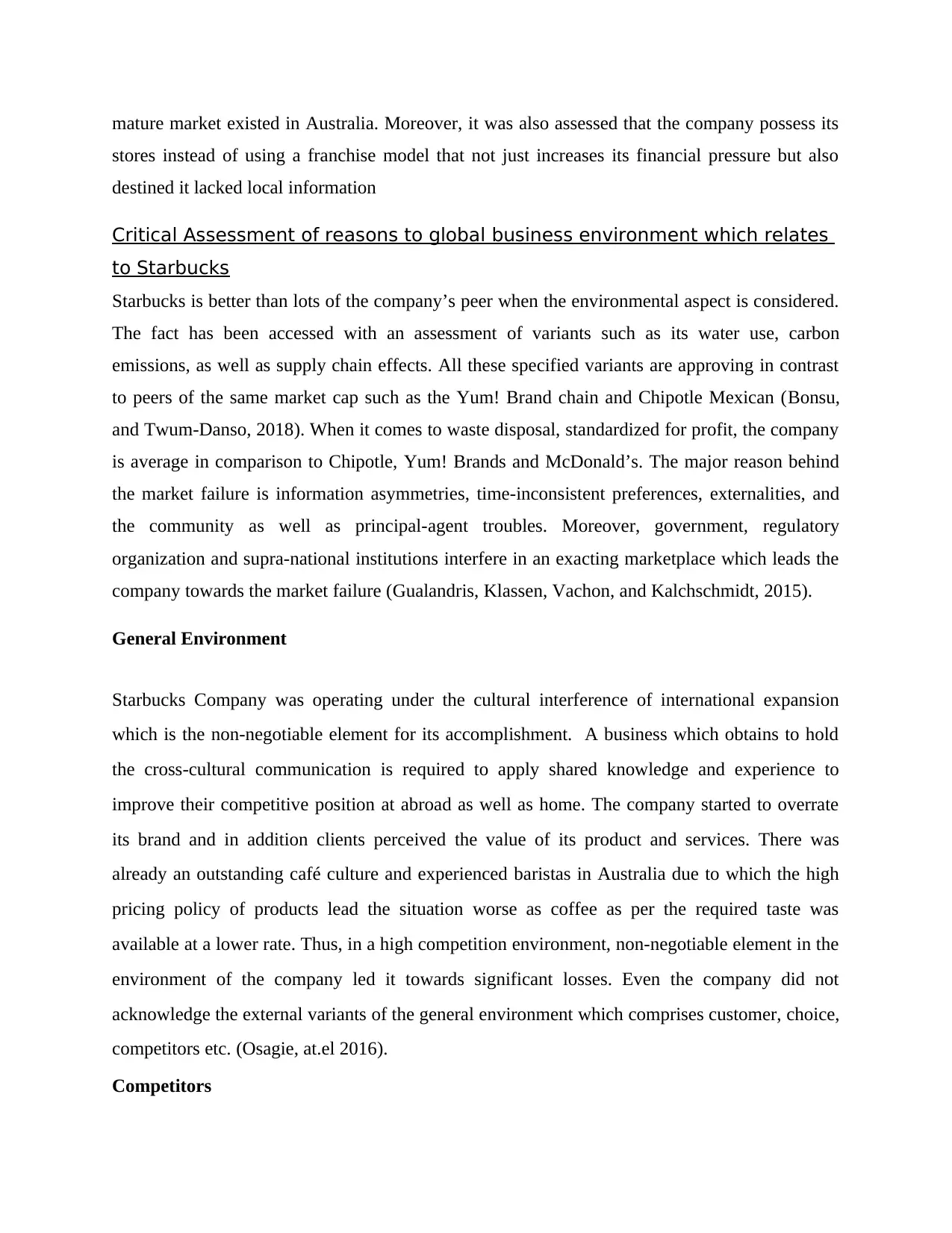
mature market existed in Australia. Moreover, it was also assessed that the company possess its
stores instead of using a franchise model that not just increases its financial pressure but also
destined it lacked local information
Critical Assessment of reasons to global business environment which relates
to Starbucks
Starbucks is better than lots of the company’s peer when the environmental aspect is considered.
The fact has been accessed with an assessment of variants such as its water use, carbon
emissions, as well as supply chain effects. All these specified variants are approving in contrast
to peers of the same market cap such as the Yum! Brand chain and Chipotle Mexican (Bonsu,
and Twum-Danso, 2018). When it comes to waste disposal, standardized for profit, the company
is average in comparison to Chipotle, Yum! Brands and McDonald’s. The major reason behind
the market failure is information asymmetries, time-inconsistent preferences, externalities, and
the community as well as principal-agent troubles. Moreover, government, regulatory
organization and supra-national institutions interfere in an exacting marketplace which leads the
company towards the market failure (Gualandris, Klassen, Vachon, and Kalchschmidt, 2015).
General Environment
Starbucks Company was operating under the cultural interference of international expansion
which is the non-negotiable element for its accomplishment. A business which obtains to hold
the cross-cultural communication is required to apply shared knowledge and experience to
improve their competitive position at abroad as well as home. The company started to overrate
its brand and in addition clients perceived the value of its product and services. There was
already an outstanding café culture and experienced baristas in Australia due to which the high
pricing policy of products lead the situation worse as coffee as per the required taste was
available at a lower rate. Thus, in a high competition environment, non-negotiable element in the
environment of the company led it towards significant losses. Even the company did not
acknowledge the external variants of the general environment which comprises customer, choice,
competitors etc. (Osagie, at.el 2016).
Competitors
stores instead of using a franchise model that not just increases its financial pressure but also
destined it lacked local information
Critical Assessment of reasons to global business environment which relates
to Starbucks
Starbucks is better than lots of the company’s peer when the environmental aspect is considered.
The fact has been accessed with an assessment of variants such as its water use, carbon
emissions, as well as supply chain effects. All these specified variants are approving in contrast
to peers of the same market cap such as the Yum! Brand chain and Chipotle Mexican (Bonsu,
and Twum-Danso, 2018). When it comes to waste disposal, standardized for profit, the company
is average in comparison to Chipotle, Yum! Brands and McDonald’s. The major reason behind
the market failure is information asymmetries, time-inconsistent preferences, externalities, and
the community as well as principal-agent troubles. Moreover, government, regulatory
organization and supra-national institutions interfere in an exacting marketplace which leads the
company towards the market failure (Gualandris, Klassen, Vachon, and Kalchschmidt, 2015).
General Environment
Starbucks Company was operating under the cultural interference of international expansion
which is the non-negotiable element for its accomplishment. A business which obtains to hold
the cross-cultural communication is required to apply shared knowledge and experience to
improve their competitive position at abroad as well as home. The company started to overrate
its brand and in addition clients perceived the value of its product and services. There was
already an outstanding café culture and experienced baristas in Australia due to which the high
pricing policy of products lead the situation worse as coffee as per the required taste was
available at a lower rate. Thus, in a high competition environment, non-negotiable element in the
environment of the company led it towards significant losses. Even the company did not
acknowledge the external variants of the general environment which comprises customer, choice,
competitors etc. (Osagie, at.el 2016).
Competitors
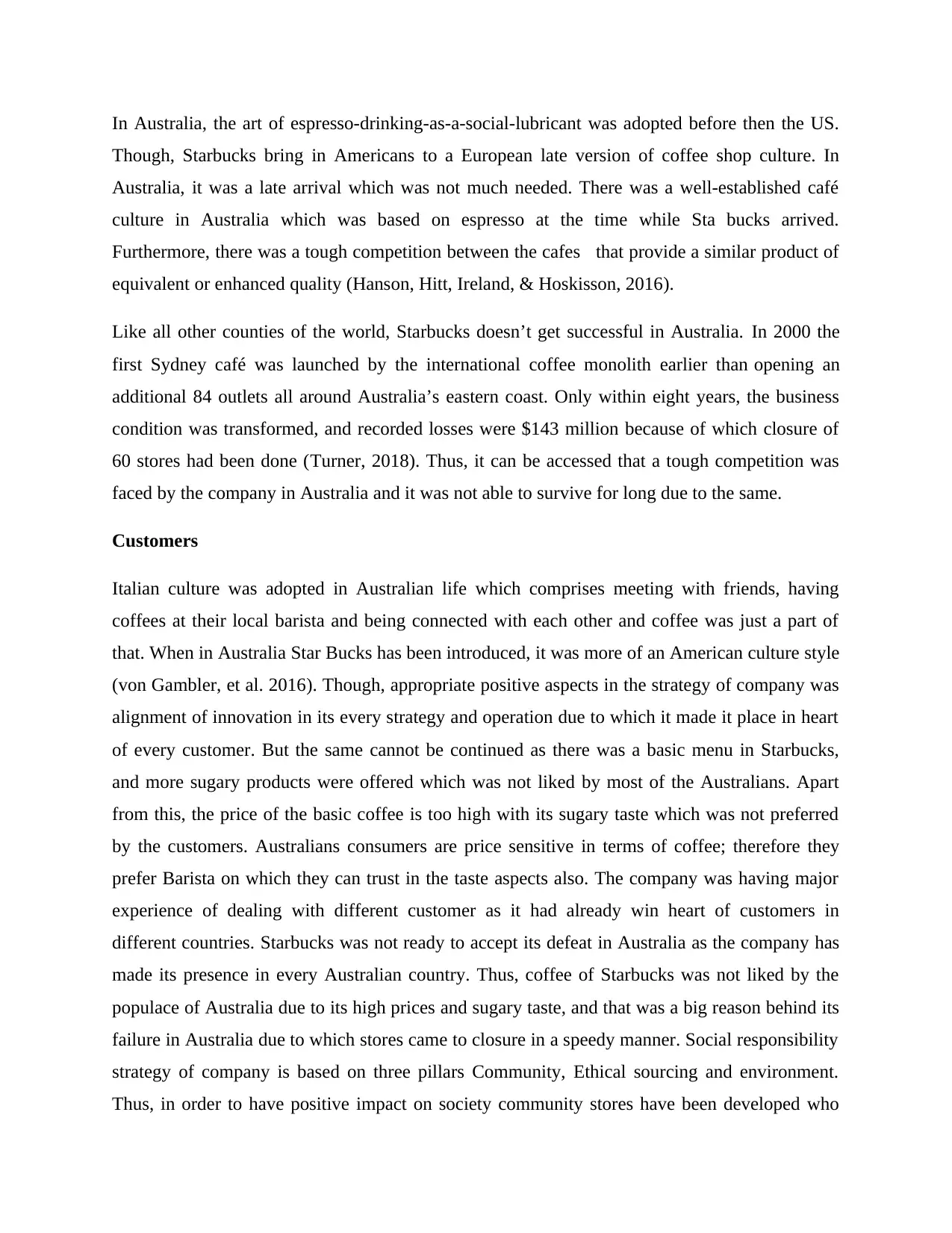
In Australia, the art of espresso-drinking-as-a-social-lubricant was adopted before then the US.
Though, Starbucks bring in Americans to a European late version of coffee shop culture. In
Australia, it was a late arrival which was not much needed. There was a well-established café
culture in Australia which was based on espresso at the time while Sta bucks arrived.
Furthermore, there was a tough competition between the cafes that provide a similar product of
equivalent or enhanced quality (Hanson, Hitt, Ireland, & Hoskisson, 2016).
Like all other counties of the world, Starbucks doesn’t get successful in Australia. In 2000 the
first Sydney café was launched by the international coffee monolith earlier than opening an
additional 84 outlets all around Australia’s eastern coast. Only within eight years, the business
condition was transformed, and recorded losses were $143 million because of which closure of
60 stores had been done (Turner, 2018). Thus, it can be accessed that a tough competition was
faced by the company in Australia and it was not able to survive for long due to the same.
Customers
Italian culture was adopted in Australian life which comprises meeting with friends, having
coffees at their local barista and being connected with each other and coffee was just a part of
that. When in Australia Star Bucks has been introduced, it was more of an American culture style
(von Gambler, et al. 2016). Though, appropriate positive aspects in the strategy of company was
alignment of innovation in its every strategy and operation due to which it made it place in heart
of every customer. But the same cannot be continued as there was a basic menu in Starbucks,
and more sugary products were offered which was not liked by most of the Australians. Apart
from this, the price of the basic coffee is too high with its sugary taste which was not preferred
by the customers. Australians consumers are price sensitive in terms of coffee; therefore they
prefer Barista on which they can trust in the taste aspects also. The company was having major
experience of dealing with different customer as it had already win heart of customers in
different countries. Starbucks was not ready to accept its defeat in Australia as the company has
made its presence in every Australian country. Thus, coffee of Starbucks was not liked by the
populace of Australia due to its high prices and sugary taste, and that was a big reason behind its
failure in Australia due to which stores came to closure in a speedy manner. Social responsibility
strategy of company is based on three pillars Community, Ethical sourcing and environment.
Thus, in order to have positive impact on society community stores have been developed who
Though, Starbucks bring in Americans to a European late version of coffee shop culture. In
Australia, it was a late arrival which was not much needed. There was a well-established café
culture in Australia which was based on espresso at the time while Sta bucks arrived.
Furthermore, there was a tough competition between the cafes that provide a similar product of
equivalent or enhanced quality (Hanson, Hitt, Ireland, & Hoskisson, 2016).
Like all other counties of the world, Starbucks doesn’t get successful in Australia. In 2000 the
first Sydney café was launched by the international coffee monolith earlier than opening an
additional 84 outlets all around Australia’s eastern coast. Only within eight years, the business
condition was transformed, and recorded losses were $143 million because of which closure of
60 stores had been done (Turner, 2018). Thus, it can be accessed that a tough competition was
faced by the company in Australia and it was not able to survive for long due to the same.
Customers
Italian culture was adopted in Australian life which comprises meeting with friends, having
coffees at their local barista and being connected with each other and coffee was just a part of
that. When in Australia Star Bucks has been introduced, it was more of an American culture style
(von Gambler, et al. 2016). Though, appropriate positive aspects in the strategy of company was
alignment of innovation in its every strategy and operation due to which it made it place in heart
of every customer. But the same cannot be continued as there was a basic menu in Starbucks,
and more sugary products were offered which was not liked by most of the Australians. Apart
from this, the price of the basic coffee is too high with its sugary taste which was not preferred
by the customers. Australians consumers are price sensitive in terms of coffee; therefore they
prefer Barista on which they can trust in the taste aspects also. The company was having major
experience of dealing with different customer as it had already win heart of customers in
different countries. Starbucks was not ready to accept its defeat in Australia as the company has
made its presence in every Australian country. Thus, coffee of Starbucks was not liked by the
populace of Australia due to its high prices and sugary taste, and that was a big reason behind its
failure in Australia due to which stores came to closure in a speedy manner. Social responsibility
strategy of company is based on three pillars Community, Ethical sourcing and environment.
Thus, in order to have positive impact on society community stores have been developed who
⊘ This is a preview!⊘
Do you want full access?
Subscribe today to unlock all pages.

Trusted by 1+ million students worldwide
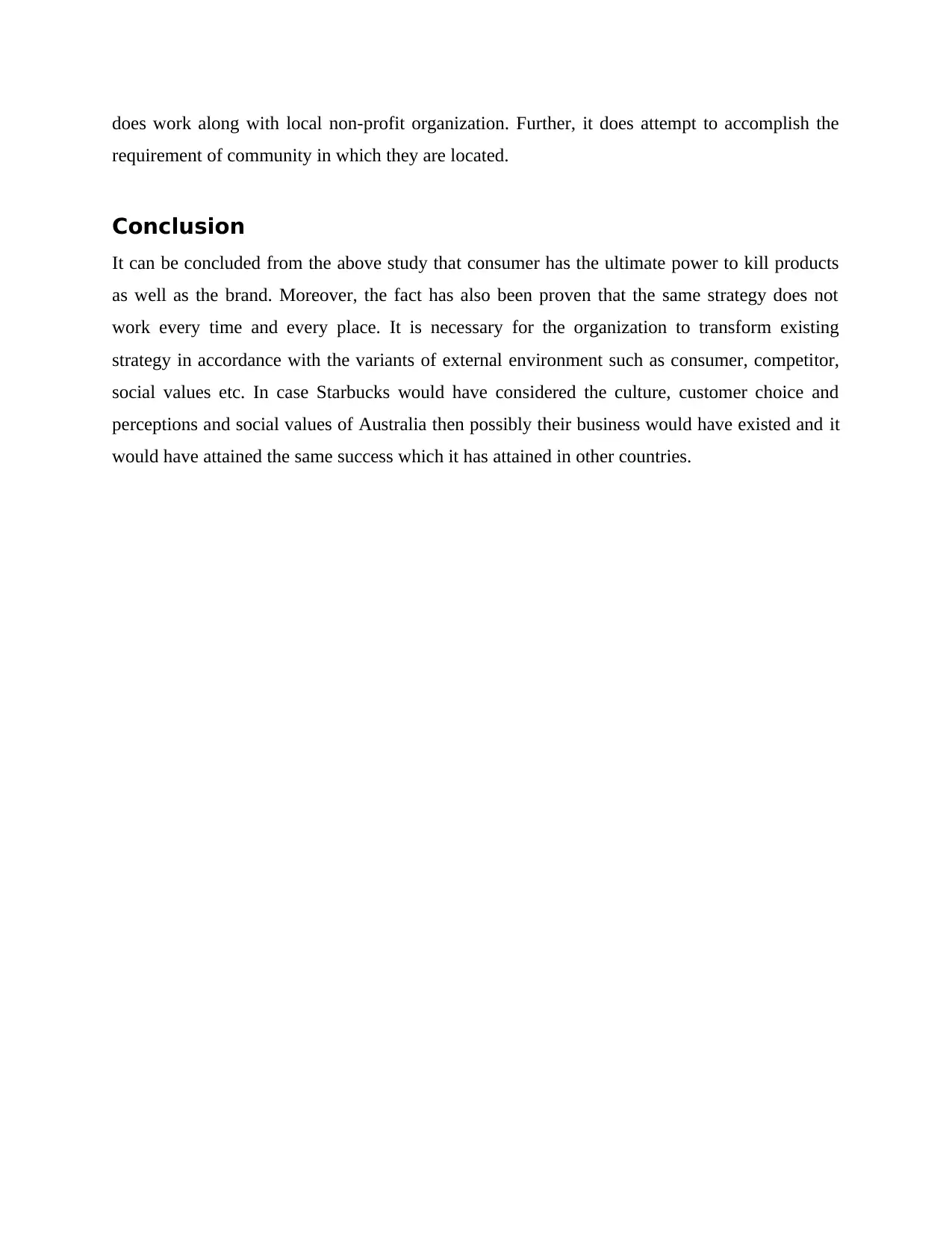
does work along with local non-profit organization. Further, it does attempt to accomplish the
requirement of community in which they are located.
Conclusion
It can be concluded from the above study that consumer has the ultimate power to kill products
as well as the brand. Moreover, the fact has also been proven that the same strategy does not
work every time and every place. It is necessary for the organization to transform existing
strategy in accordance with the variants of external environment such as consumer, competitor,
social values etc. In case Starbucks would have considered the culture, customer choice and
perceptions and social values of Australia then possibly their business would have existed and it
would have attained the same success which it has attained in other countries.
requirement of community in which they are located.
Conclusion
It can be concluded from the above study that consumer has the ultimate power to kill products
as well as the brand. Moreover, the fact has also been proven that the same strategy does not
work every time and every place. It is necessary for the organization to transform existing
strategy in accordance with the variants of external environment such as consumer, competitor,
social values etc. In case Starbucks would have considered the culture, customer choice and
perceptions and social values of Australia then possibly their business would have existed and it
would have attained the same success which it has attained in other countries.
Paraphrase This Document
Need a fresh take? Get an instant paraphrase of this document with our AI Paraphraser
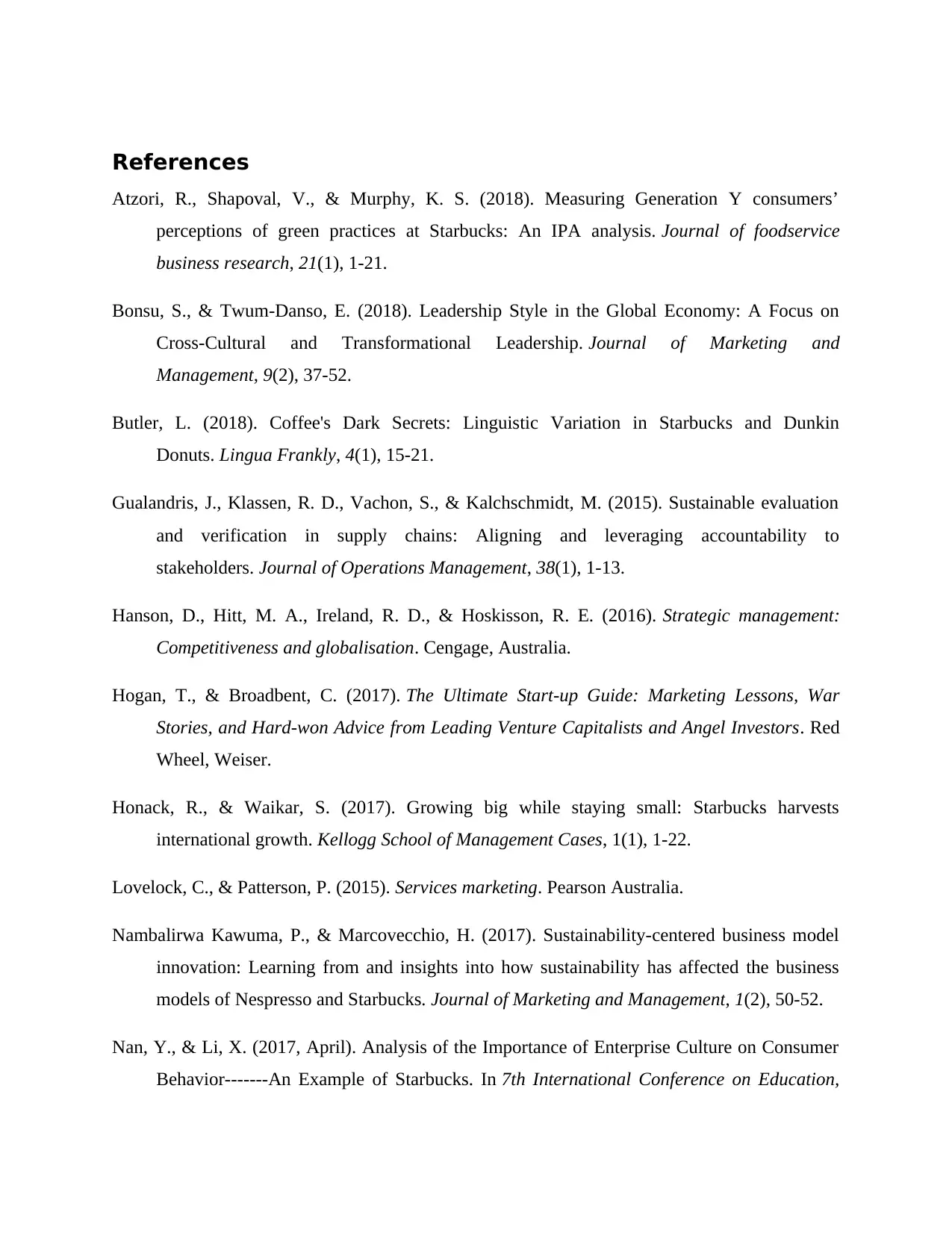
References
Atzori, R., Shapoval, V., & Murphy, K. S. (2018). Measuring Generation Y consumers’
perceptions of green practices at Starbucks: An IPA analysis. Journal of foodservice
business research, 21(1), 1-21.
Bonsu, S., & Twum-Danso, E. (2018). Leadership Style in the Global Economy: A Focus on
Cross-Cultural and Transformational Leadership. Journal of Marketing and
Management, 9(2), 37-52.
Butler, L. (2018). Coffee's Dark Secrets: Linguistic Variation in Starbucks and Dunkin
Donuts. Lingua Frankly, 4(1), 15-21.
Gualandris, J., Klassen, R. D., Vachon, S., & Kalchschmidt, M. (2015). Sustainable evaluation
and verification in supply chains: Aligning and leveraging accountability to
stakeholders. Journal of Operations Management, 38(1), 1-13.
Hanson, D., Hitt, M. A., Ireland, R. D., & Hoskisson, R. E. (2016). Strategic management:
Competitiveness and globalisation. Cengage, Australia.
Hogan, T., & Broadbent, C. (2017). The Ultimate Start-up Guide: Marketing Lessons, War
Stories, and Hard-won Advice from Leading Venture Capitalists and Angel Investors. Red
Wheel, Weiser.
Honack, R., & Waikar, S. (2017). Growing big while staying small: Starbucks harvests
international growth. Kellogg School of Management Cases, 1(1), 1-22.
Lovelock, C., & Patterson, P. (2015). Services marketing. Pearson Australia.
Nambalirwa Kawuma, P., & Marcovecchio, H. (2017). Sustainability-centered business model
innovation: Learning from and insights into how sustainability has affected the business
models of Nespresso and Starbucks. Journal of Marketing and Management, 1(2), 50-52.
Nan, Y., & Li, X. (2017, April). Analysis of the Importance of Enterprise Culture on Consumer
Behavior-------An Example of Starbucks. In 7th International Conference on Education,
Atzori, R., Shapoval, V., & Murphy, K. S. (2018). Measuring Generation Y consumers’
perceptions of green practices at Starbucks: An IPA analysis. Journal of foodservice
business research, 21(1), 1-21.
Bonsu, S., & Twum-Danso, E. (2018). Leadership Style in the Global Economy: A Focus on
Cross-Cultural and Transformational Leadership. Journal of Marketing and
Management, 9(2), 37-52.
Butler, L. (2018). Coffee's Dark Secrets: Linguistic Variation in Starbucks and Dunkin
Donuts. Lingua Frankly, 4(1), 15-21.
Gualandris, J., Klassen, R. D., Vachon, S., & Kalchschmidt, M. (2015). Sustainable evaluation
and verification in supply chains: Aligning and leveraging accountability to
stakeholders. Journal of Operations Management, 38(1), 1-13.
Hanson, D., Hitt, M. A., Ireland, R. D., & Hoskisson, R. E. (2016). Strategic management:
Competitiveness and globalisation. Cengage, Australia.
Hogan, T., & Broadbent, C. (2017). The Ultimate Start-up Guide: Marketing Lessons, War
Stories, and Hard-won Advice from Leading Venture Capitalists and Angel Investors. Red
Wheel, Weiser.
Honack, R., & Waikar, S. (2017). Growing big while staying small: Starbucks harvests
international growth. Kellogg School of Management Cases, 1(1), 1-22.
Lovelock, C., & Patterson, P. (2015). Services marketing. Pearson Australia.
Nambalirwa Kawuma, P., & Marcovecchio, H. (2017). Sustainability-centered business model
innovation: Learning from and insights into how sustainability has affected the business
models of Nespresso and Starbucks. Journal of Marketing and Management, 1(2), 50-52.
Nan, Y., & Li, X. (2017, April). Analysis of the Importance of Enterprise Culture on Consumer
Behavior-------An Example of Starbucks. In 7th International Conference on Education,
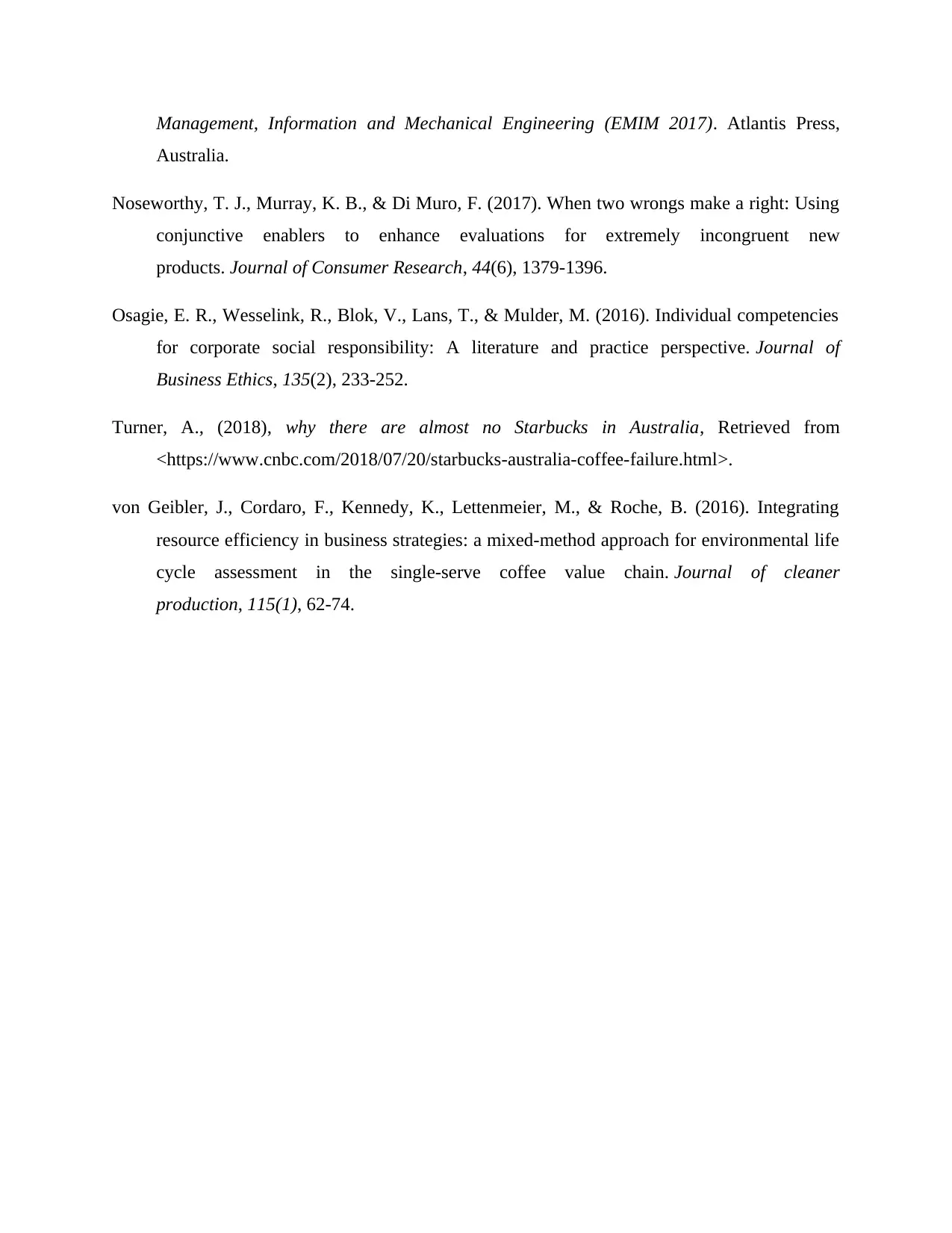
Management, Information and Mechanical Engineering (EMIM 2017). Atlantis Press,
Australia.
Noseworthy, T. J., Murray, K. B., & Di Muro, F. (2017). When two wrongs make a right: Using
conjunctive enablers to enhance evaluations for extremely incongruent new
products. Journal of Consumer Research, 44(6), 1379-1396.
Osagie, E. R., Wesselink, R., Blok, V., Lans, T., & Mulder, M. (2016). Individual competencies
for corporate social responsibility: A literature and practice perspective. Journal of
Business Ethics, 135(2), 233-252.
Turner, A., (2018), why there are almost no Starbucks in Australia, Retrieved from
<https://www.cnbc.com/2018/07/20/starbucks-australia-coffee-failure.html>.
von Geibler, J., Cordaro, F., Kennedy, K., Lettenmeier, M., & Roche, B. (2016). Integrating
resource efficiency in business strategies: a mixed-method approach for environmental life
cycle assessment in the single-serve coffee value chain. Journal of cleaner
production, 115(1), 62-74.
Australia.
Noseworthy, T. J., Murray, K. B., & Di Muro, F. (2017). When two wrongs make a right: Using
conjunctive enablers to enhance evaluations for extremely incongruent new
products. Journal of Consumer Research, 44(6), 1379-1396.
Osagie, E. R., Wesselink, R., Blok, V., Lans, T., & Mulder, M. (2016). Individual competencies
for corporate social responsibility: A literature and practice perspective. Journal of
Business Ethics, 135(2), 233-252.
Turner, A., (2018), why there are almost no Starbucks in Australia, Retrieved from
<https://www.cnbc.com/2018/07/20/starbucks-australia-coffee-failure.html>.
von Geibler, J., Cordaro, F., Kennedy, K., Lettenmeier, M., & Roche, B. (2016). Integrating
resource efficiency in business strategies: a mixed-method approach for environmental life
cycle assessment in the single-serve coffee value chain. Journal of cleaner
production, 115(1), 62-74.
⊘ This is a preview!⊘
Do you want full access?
Subscribe today to unlock all pages.

Trusted by 1+ million students worldwide
1 out of 9
Related Documents
Your All-in-One AI-Powered Toolkit for Academic Success.
+13062052269
info@desklib.com
Available 24*7 on WhatsApp / Email
![[object Object]](/_next/static/media/star-bottom.7253800d.svg)
Unlock your academic potential
Copyright © 2020–2025 A2Z Services. All Rights Reserved. Developed and managed by ZUCOL.





